The Royal Ship Vasa...
Let's begin by taking a stroll around this mighty ship, let's get a sense of what we are about to board and absorb the incredible scale and elegance of this vessel--a vessel brought back from the dead after 333 years on the bottom of Stockholm Harbor....
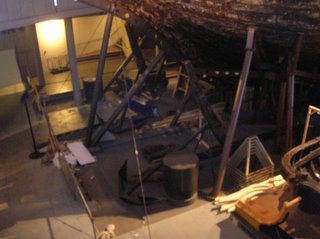
The floor we stand on lies level with the Vasa's waterline. Below us some 2o feet or more lie two of Vasa's 4 mammoth anchors: they are among the few iron pieces to survive. In the high acidity of the harbor mud most metal was dissolved, but the anchors are so massive that even the centuries of exposure to this acid environment could not destroy them.
 Moving around the port bow we can look down on Vasa's small boat--by small, I mean just over 30ft which makes her as big as any fishing vessel of her time or decent modern yacht. This boat was Vasa's main tender and was found beside her on the bottom, probably towed under by the lines that tethered it to the ship.
Moving around the port bow we can look down on Vasa's small boat--by small, I mean just over 30ft which makes her as big as any fishing vessel of her time or decent modern yacht. This boat was Vasa's main tender and was found beside her on the bottom, probably towed under by the lines that tethered it to the ship. Two other small boats were found on the site. One lay inside the main tender and the other was found crushed under Vasa's keel. Analysis revealed that it was a much older wreck and had suffered two grave misfortunes; first it sank, then the 700-ton Vasa came plunging down on top of it.
 Next we pass along Vasa's mighty broadside. With a total of 56 gunports for 24-pounder cannon, Vasa was without doubt the most powerful and heavily-armed ship anywhere in the Baltic--and as far we know, anywhere in the world.
Next we pass along Vasa's mighty broadside. With a total of 56 gunports for 24-pounder cannon, Vasa was without doubt the most powerful and heavily-armed ship anywhere in the Baltic--and as far we know, anywhere in the world. The two full gundecks was an experimental design in the 1620s. The Danish had built a few, but none capable of the ferocious wall of fire Vasa could dish out.
It was these gunports here on the port side that were left open when the ship sailed, firing salutes as she crossed the harbor. Then, with a gust of wind, she heeled over and the water gushed in the lower gunports and Vasa heeled further, steadied a bit, and then horiffically sank from view until only her topmasts were visible, the colorful penants sweeping the surface of the bay. The shock and embarassment was thoroughly devastating and it was not until more than a century later that another Swedish ship sailed under the name Vasa.
Next we round Vasa's stunningly ornamented stern. Several hundred of her total 700 sculptures hang here. Yet, for all its beauty, the stern of Vasa was designed to include 4 of the mighty 'long 24s' aimed aft through the gunports shown here.
This shot also begins to offer some idea of the terrific height of the after portion of the ship. The waterline would be just below the top of the cradle and only about half of what towers above it is even visible in this photo.
 Climbing up a level, we round the stern and come up along the starboard side, now able to gaze down on the rows and rows of menacing gunports, the now-empty dens of the most venomous killers of the 1620s--the new, modern 24-pounder cannon.
Climbing up a level, we round the stern and come up along the starboard side, now able to gaze down on the rows and rows of menacing gunports, the now-empty dens of the most venomous killers of the 1620s--the new, modern 24-pounder cannon.
Barely over half the length and weight of traditional 'long 24' (of which Vasa carried a only few), the modern 24-pounder could inflict just as much damage and almost as accurately as the old 24 for a fraction of the weight. That meant more guns could be placed on the ship and enabled Vasa to blow the 20-gun Baltic naval standard out of the water with the introduction of this 56-gun giant. That in mind, do not be deceived by the beautifully ornamented gunport frames on the upperdeck.
That in mind, do not be deceived by the beautifully ornamented gunport frames on the upperdeck.
Even these small ports, intended for the 3-pounders, attest to the dedication of Vasa's design to maximize firepower.

Below them , Vasa's maingunports make no attempt to conceal thier violent purpose with peaceful wreath carvings. Instead, each gunport cover is studded with iron nails and dominated by the carved head of a snarling lion.
This gunport, like all the forward gunports, has an angled frame to allow the cannon to be trained ahead of the ship to fire repeatedly on passing targets.
 Coming up to the bow we can see the solid, pear-shape of Vasa's hull, her bulging belly filled with cannon.
Coming up to the bow we can see the solid, pear-shape of Vasa's hull, her bulging belly filled with cannon. 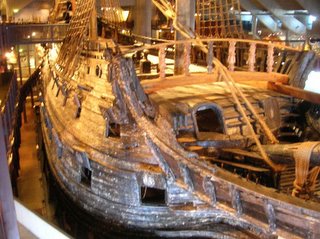 And yet the bow retains a sleek and delicate figure in its sweepig timbers and ornate sculpture. However, it remains clear that this is no ship to be tangled with...
And yet the bow retains a sleek and delicate figure in its sweepig timbers and ornate sculpture. However, it remains clear that this is no ship to be tangled with...But I suppose you are all eager to get aboard. So we'll back up a bit to that catwalk in the upper left reaching over the starboard rail, switch off the alarm, and step into this resurrected ghostship.
GOING ABOARD
THE UPPERDECK OR WEATHERDECK
 Crossing the gangplank is an experience in itself and it is a shame that the visitors cannot do this. To look straight down on the bulging hull and the gaping gunports or to cross that line of perspective that divides being 'aboard' and 'not aboard'.
Crossing the gangplank is an experience in itself and it is a shame that the visitors cannot do this. To look straight down on the bulging hull and the gaping gunports or to cross that line of perspective that divides being 'aboard' and 'not aboard'. At the foot of the gangplank we are greeted by one of Vasa's 3 enormous capstans, complete with ornamented pawls and bars.
At the foot of the gangplank we are greeted by one of Vasa's 3 enormous capstans, complete with ornamented pawls and bars.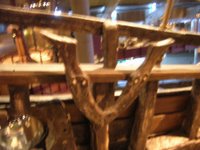 Across the deck ont he port side we are drawn to one of Vasa's typically Nordic-looking cleats.
Across the deck ont he port side we are drawn to one of Vasa's typically Nordic-looking cleats.  Leaning over the rail to peer at Vasa's open gunport covers, we get a sense of her gigantic size. This is only amidships (the lowest area of the upperdeck), and yet the keel and the floor of the shiphall are more than 50 feet below.
Leaning over the rail to peer at Vasa's open gunport covers, we get a sense of her gigantic size. This is only amidships (the lowest area of the upperdeck), and yet the keel and the floor of the shiphall are more than 50 feet below. Tracking back toward the gangplank, let us go forward. The capstan dominates the deck forward of amidships. Around its base the gaping hatches offer a glimpse into the deep hull. Just forward of those, a pair sculptured shivved bitts stand as firmly as they have for 378 years, guarding the base of the lofty foremast--the only one still standing when the ship was raised in 1961.
Tracking back toward the gangplank, let us go forward. The capstan dominates the deck forward of amidships. Around its base the gaping hatches offer a glimpse into the deep hull. Just forward of those, a pair sculptured shivved bitts stand as firmly as they have for 378 years, guarding the base of the lofty foremast--the only one still standing when the ship was raised in 1961.For a sense of scale, the blurry critter gazing at the enormous mainstay deadeyes from the foot of the foremast is myself.
 Glancing over the foredeck ballistrade one is treated to the thrilling sight of Vasa's strident beakhead. Extending more than 10 meters from the hull, this elegant rostrum evoked the majesty of the ship's lines and recollections of the ramming Triremes of olde.
Glancing over the foredeck ballistrade one is treated to the thrilling sight of Vasa's strident beakhead. Extending more than 10 meters from the hull, this elegant rostrum evoked the majesty of the ship's lines and recollections of the ramming Triremes of olde.The timber on the right is the cathead from which the anchor was hung. Beneath it, the subtle Swedes placed a sculpture of a Danish noble being crushed by the weight.
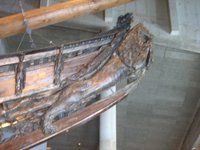 At the end of the beakhead is Vasa's mighty lion, the figurehead of the Vasa family and the symbol of royalty and power throughout Europe.
At the end of the beakhead is Vasa's mighty lion, the figurehead of the Vasa family and the symbol of royalty and power throughout Europe.
Turning around, we proceed aft toward the progressively higher and higher decks of the stern. You will note the remarkably new-looking panking of the deck. Indeed, this is new. The upper deck was torn off by salvors in 1664-1665 when they descended in diving bells to strip the ship of its valuable bronze cannon. Using a variety of iron implements, the planks were torn free and either heaved over the side or taken away. The now-yellowing records report some"32 cartloads of wood" were were hauled away never to be seen again.
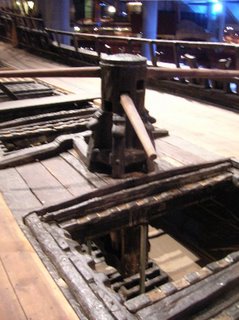 As we pass the capstan again we can glance down the hatch and see the unusual "hanging capstan" design with the base mounted in a wooden box hanging from the underside of the deck rather than seated on the deck below like most capstans.
As we pass the capstan again we can glance down the hatch and see the unusual "hanging capstan" design with the base mounted in a wooden box hanging from the underside of the deck rather than seated on the deck below like most capstans. Amidships we come to Vasa's enormous mainmast. Each mast was vertically composed of three major sections. Despite the great height of the exhibit hall, only the lowest section of each mast can stand inside.
Amidships we come to Vasa's enormous mainmast. Each mast was vertically composed of three major sections. Despite the great height of the exhibit hall, only the lowest section of each mast can stand inside.
The lower portion of Vasa's mainmast is so thick that it could not be made from a single tree. It is layed together from 7 pieces and bound together with rope called 'woolding'.
When Vasa was excavated in the early 1960s, the mainmast was found lying beside the ship. It had been broken off at the deck. Because Vasa lay in only 33 meters of water, the tops of her masts had stood above the surface after she sank. They were then cut off below the surface by order of the King--eager to remove any reminder of the disaster. Thereafter, the main and fore masts stood only two or three meters below the surface. At some point during the next century or so, the mainmast (and later the top of the foremast as well) was struck by a passing vessel and snapped off at the deck.
 At the base of the mainmast stands another sculpted shivved bitt. The lines passing through this block would have been the maintopsail sheets. Standing erect on the deck for 333 years on the harbor bottom, the particles drifting in the current slowly sand-blasted the ornate bust carved into its top, leaving us with just this worn, alien head.
At the base of the mainmast stands another sculpted shivved bitt. The lines passing through this block would have been the maintopsail sheets. Standing erect on the deck for 333 years on the harbor bottom, the particles drifting in the current slowly sand-blasted the ornate bust carved into its top, leaving us with just this worn, alien head.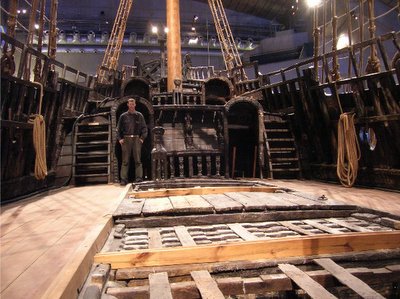 Just aft of the mainmast lie a few more hatches to the lower decks and then the upperdeck begins to rise in a series of steps to the high promontory of the poopdeck--so high that no following sea could ever have conceivably 'pooped' it.
Just aft of the mainmast lie a few more hatches to the lower decks and then the upperdeck begins to rise in a series of steps to the high promontory of the poopdeck--so high that no following sea could ever have conceivably 'pooped' it.Also, note the height of the bulwarks here--well over my head. The thin rail along its tops would have been hung with bright red decorative cloths.
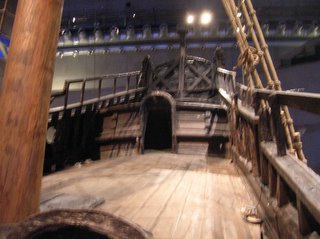
Climbing higher still past the arched entryways to the officers cabins and wardrooms, we reach the pinnacle from where the ship was commanded during her short voyage.

It was from here that Kapten Hans Jonsson (whom you've met in a previous posting) gazed out over the unparalleled ship under his charge as she set sail. Stockholm Harbor was spread out before and below him. Above, the enormous expanse of flaxen sails unfurled one-by-one to catch the summer breeze that pushed through the rigging and set the colorful royal penants waving from the tops. A sudden heavy thud and a faint tremor from deep down in the ship told of another grand salute from the 24-pounders and the subsequent crack echoing from the cliffs would have sent the seabirds whirling into the air and the Sunday spectators ashore into a frenzy of waving and whooping.
 The view must have been incredible. Here you can just see the top of the poopdeck some 45 feet above the waterline and nearly 60 feet above the keel. The waterline in this photo is even with the viewing floor in the lower right.
The view must have been incredible. Here you can just see the top of the poopdeck some 45 feet above the waterline and nearly 60 feet above the keel. The waterline in this photo is even with the viewing floor in the lower right. Leaning over the poopdeck rail to sight the tiny figures walking about below is to take a chance with vertigo. This shot is from the mizzen shrouds, still a good five feet below the highest part of the deck. The ornate tower just over the curve of the hull is the port gallery, a fancy decorative 'porch' that wraps around the stern of the ship.
Leaning over the poopdeck rail to sight the tiny figures walking about below is to take a chance with vertigo. This shot is from the mizzen shrouds, still a good five feet below the highest part of the deck. The ornate tower just over the curve of the hull is the port gallery, a fancy decorative 'porch' that wraps around the stern of the ship.
Entering through one of the arched doorways we enter the wardroom and find Fred Hocker in typical Swedish work cloths poking about between the frames with a flashlight. Someone had brought us a sawed-off timber and claimed it was from Vasa. The story went that it was cut off in order to enable the salvage crew to reinforce the shattered stern when refloating the ship. Fred and I searched for a while and found a few places it could have come from, but nothing conclusive yet.
The very new-looking door was added in the 1960s when a few non-preservation-minded showboaters thought they could rebuild the officers cabins to entertain tourists.
 This cabin suffered terribly. It is the highest portion of the ship and is not really part of the structural core of the vessel. Therefore it took a beating from the scouring and eroding currents and stood ready to bare the brunt of any impact from anchors or the like. Some time during the 1860s when a graving dock was being built on the nearby island of Beckholmen (100m to the north), a construction crew dumped a 300-ton load of shattered rock in the bay directly over Vasa's delicate stern. It was immediately crushed into thousands of fragments and pinned to the lowerecks under the pile of rubble.
This cabin suffered terribly. It is the highest portion of the ship and is not really part of the structural core of the vessel. Therefore it took a beating from the scouring and eroding currents and stood ready to bare the brunt of any impact from anchors or the like. Some time during the 1860s when a graving dock was being built on the nearby island of Beckholmen (100m to the north), a construction crew dumped a 300-ton load of shattered rock in the bay directly over Vasa's delicate stern. It was immediately crushed into thousands of fragments and pinned to the lowerecks under the pile of rubble. After the excavation of Vasa began in 1959, reconstructuion crews spent countless hours painstakingly tagging every fragment of shattered wood with a find number and detailed information on where it was found. Slowly, but surely they pieced the Vasa's great cabin and entire stern portion back together. This circular steel tag is one of more than 29,000 that mark pieces of Vasa (and the little boat she fell on).
After the excavation of Vasa began in 1959, reconstructuion crews spent countless hours painstakingly tagging every fragment of shattered wood with a find number and detailed information on where it was found. Slowly, but surely they pieced the Vasa's great cabin and entire stern portion back together. This circular steel tag is one of more than 29,000 that mark pieces of Vasa (and the little boat she fell on).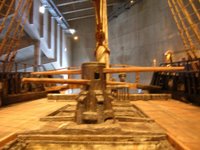 Emerging back on deck we go forward to the capstan again....
Emerging back on deck we go forward to the capstan again.... ...and then we drop through a hatch and plunge into Vasa's deep, dark hold....
...and then we drop through a hatch and plunge into Vasa's deep, dark hold....THE UPPERGUNDECK
 Coming down a modern wooden ladder, we see Vasa's original graceful, curving ladders--eroded and scoured by the currents too--still standing under the hatchgratings.
Coming down a modern wooden ladder, we see Vasa's original graceful, curving ladders--eroded and scoured by the currents too--still standing under the hatchgratings. Then we find ourselves in the uppergundeck. There is a crushing, overbearing feeling to the space embodied in the gigantic, solid knees and deckbeams that hang over the gundeck. Yet, there is also a sense of an enormity of interior space. It is like the hangardeck of an aircraft carrier, but no one would want to see anything in here on wheels unless it was firmly lashed down. The sheer of the deck is astounding, swooping from bow to stern so sharply as to make one wonder if it is collapsing underfoot.
Then we find ourselves in the uppergundeck. There is a crushing, overbearing feeling to the space embodied in the gigantic, solid knees and deckbeams that hang over the gundeck. Yet, there is also a sense of an enormity of interior space. It is like the hangardeck of an aircraft carrier, but no one would want to see anything in here on wheels unless it was firmly lashed down. The sheer of the deck is astounding, swooping from bow to stern so sharply as to make one wonder if it is collapsing underfoot.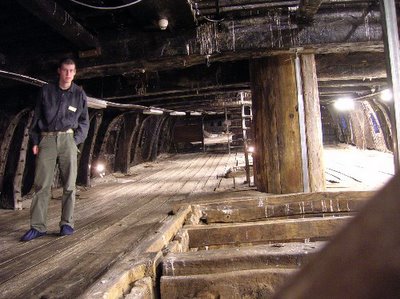
Stepping off the protective cloth covering to the bare planking of the starboard side, we find that if one stands forward of amidships, the curve of the deck is so severe that it is impossible to see anything above the floor of the sterncabins. The overhead beams hang too low in the sag of the decks. That is a remarkable fact considering the unusually high headroom in Vasa--six inches higher than the average man of the time and a part of why Vasa was so unstable. Her decks were too high.
 Even though there are no cannon on the gundecks anymore, it is hard to forget where you are. The Uppergundeck carried 24 of the 24-pounder cannon and every ten feet or so there is another gunport, another opening to the outside world and another way for the seas to come in...
Even though there are no cannon on the gundecks anymore, it is hard to forget where you are. The Uppergundeck carried 24 of the 24-pounder cannon and every ten feet or so there is another gunport, another opening to the outside world and another way for the seas to come in... This is looking stright forward on the uppergundeck. The large structure in the middle is the bitts where the anchor line was secured.
This is looking stright forward on the uppergundeck. The large structure in the middle is the bitts where the anchor line was secured. These bitts are really quite something. They are enormous timbers of the like that I am sure exist almost nowhere in Sweden today. Six-feet tall, ten feet wide, and nearly a meter thick anywhere, these held the entire strain of the ship against the wind or tide.
These bitts are really quite something. They are enormous timbers of the like that I am sure exist almost nowhere in Sweden today. Six-feet tall, ten feet wide, and nearly a meter thick anywhere, these held the entire strain of the ship against the wind or tide.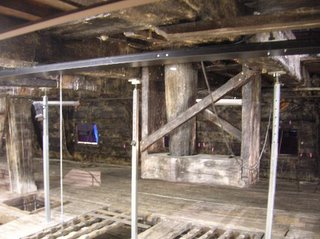 From the uppergundeck we also get a great look at the hanging capstan in its little box. Odd the way it does not go all the way down to the deck-some poor sailor must have always been walking into the thing....
From the uppergundeck we also get a great look at the hanging capstan in its little box. Odd the way it does not go all the way down to the deck-some poor sailor must have always been walking into the thing....The thin steel posts have been recently added as a measure to curb the slow collapse of the entire ship. Her oversized deckbeams are so heavy that the hull is slowly bulging outward and the decks are lowering. These should transfer the load directly to the keel.
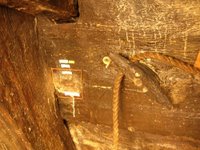 All over the shi pyou will see these squares outlined in red thread. These are test areas where different treatments are being applied to the sulphur outbreaks that threaten to devour Vasa. The wooden cleat is an orignial and was used to secure the pull-rope for opening a gunport. The port is directly below it out of the frame.
All over the shi pyou will see these squares outlined in red thread. These are test areas where different treatments are being applied to the sulphur outbreaks that threaten to devour Vasa. The wooden cleat is an orignial and was used to secure the pull-rope for opening a gunport. The port is directly below it out of the frame. Immensity seems to be the dominant theme in Vasa. For instance, this huge, solid, oak plank is just one of hundreds.
Immensity seems to be the dominant theme in Vasa. For instance, this huge, solid, oak plank is just one of hundreds. Working our way aft through the uppergundeck we reach the helmsman's compartment. Vasa was steered using a whipstaff (the tall wooden post). The helmsman would stand on the bench at the right and push the whipstaff to port or starboard. Passing through the wooden bearing on the deck, the whipstaff was connected to the end of the tiller--the lever arm running back to the rudder. The ladder leads to the upperdeck.
Working our way aft through the uppergundeck we reach the helmsman's compartment. Vasa was steered using a whipstaff (the tall wooden post). The helmsman would stand on the bench at the right and push the whipstaff to port or starboard. Passing through the wooden bearing on the deck, the whipstaff was connected to the end of the tiller--the lever arm running back to the rudder. The ladder leads to the upperdeck. This cutaway model of Vasa shows the helmsman on the whipstaff.
This cutaway model of Vasa shows the helmsman on the whipstaff.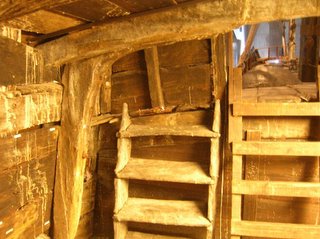 The ladders lead out onto the quarterdeck and stand on either side of a sculptured grating through which the helsman can keep an eye ahead and aloft.
The ladders lead out onto the quarterdeck and stand on either side of a sculptured grating through which the helsman can keep an eye ahead and aloft. Helmsman's view of the maindeck.
Helmsman's view of the maindeck. Just aft of the steering compartment is the Admirals Cabin. This was the 'floating embassy' portion of the ship. Ornately detailed, this space would have hosted foreign dignitaries in ports all over the Baltic. Treaties, trade agreements, and perhaps even a military surrender would have been negotiated in this cabin... if Vasa had ever made it out of Stockholm.
Just aft of the steering compartment is the Admirals Cabin. This was the 'floating embassy' portion of the ship. Ornately detailed, this space would have hosted foreign dignitaries in ports all over the Baltic. Treaties, trade agreements, and perhaps even a military surrender would have been negotiated in this cabin... if Vasa had ever made it out of Stockholm.
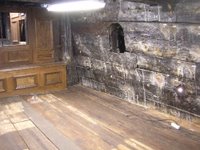
Unfortunately, this cabin was redecorated in the 1960s. Much of the new wood has been removed again and all that remains is pieces based on remnants of original woodwork. We can at least be assured of its accuracy even if not its authenticity.
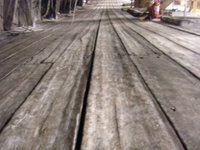 Going forward again through the uppergundeck we notice the severe erosion of the planking, carved into sallowed surfaces marred with the stains of long-ago corroded nails. This too is the work of the currents.
Going forward again through the uppergundeck we notice the severe erosion of the planking, carved into sallowed surfaces marred with the stains of long-ago corroded nails. This too is the work of the currents.THE LOWERGUNDECK
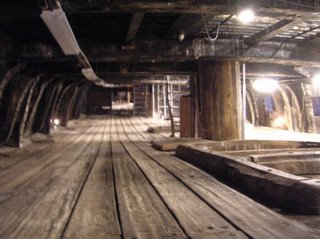
Dropping down another hatch we go deeper into Vasa. Now we are standing on the Lowergundeck. Wider and higher than the one above, the lower gundeck held another 28 of the mighty 24-pounder cannon. Having so much weight and firepower overhead, the beams in here are so massive as to put almost any other ship to shame--particularly when one realizes that these, too, are solid oak.
 Moving aft we pass the main bilge pump. The pipe is made from a single, bored-out log and still has its bark after nearly four centuries. When Vasa slid into the water in 1627, some poor sap from the yard probably had the pleasure of pumping for hours while the seams swelled and tightened up.
Moving aft we pass the main bilge pump. The pipe is made from a single, bored-out log and still has its bark after nearly four centuries. When Vasa slid into the water in 1627, some poor sap from the yard probably had the pleasure of pumping for hours while the seams swelled and tightened up. A little further aft we find the huge tiller (big timber near the top) driven by the whipstaff a deck above.
A little further aft we find the huge tiller (big timber near the top) driven by the whipstaff a deck above.  Then we drop down a small, time-worn hatch to the Orlopp.
Then we drop down a small, time-worn hatch to the Orlopp.
THE ORLOPP
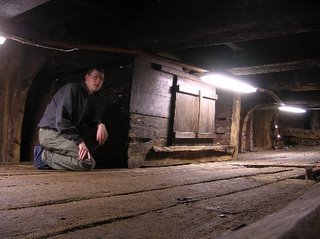
The Orlopp is a low storage deck, right about at the waterline. It was typically filled with casks of stores for maintaining the ship and the crew. The wooden compartment beside me here was the carpenter's store and was filled with a variety of tools which are now on display in the museum. Had this deck been loaded with provisions when Vasa sailed, she would have been much more stable. Instead, she was light down low making for a top-heavy ship.

There were two cannon on the Orlopp. They were on the highest part of the deck way back in the stern. These were "chasers," cannon facing astern to fend of any pursuing vessels.
Judging by the enormous carriages found stowed in this compartment, the two chasers on this deck were probably the old 'long 24s.' These massive guns were good to place low in the ship. Yet, to fire and operate one of those cantankerous beasts in this low space must have been a major challenge (however, because the carriages had closed cap-squares and were not lashed at their ports, it is assumed that these two cannon were among the eight never delivered before Vasa sailed).
THE HOLD
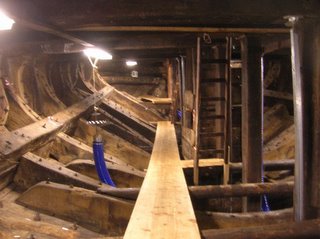
Dropping down yet one more hatch we arrive in the very bottom of Vasa, the hold. Here lies the deepest part of the ship's soul, enshrined betwen her mightiest timbers--the massive ribs and the keel itself. This is where more than 100 tons of provisions was suposed to be stowed and another 200-300 tons of ballast stones.
During the investigation of the sinking, the man in charge of ballast claimed he had filled every available space up to the level of the boardwalk shown here. It was not until the ship was raised in the 1961 that this part of his testimony was disproven. Vasa could have carried more ballast.
 A remarkable feature of the hold is the rough-hewn poles nailed down across the ballast. These were the beams for the temporary deck that was laid over the ballast to keep it in place and to keep the cargo above the bilge and dry. Like several construction decisions in the ship, it seems to indicate a hurried effort to finish the ship. War was on the horizon.
A remarkable feature of the hold is the rough-hewn poles nailed down across the ballast. These were the beams for the temporary deck that was laid over the ballast to keep it in place and to keep the cargo above the bilge and dry. Like several construction decisions in the ship, it seems to indicate a hurried effort to finish the ship. War was on the horizon. 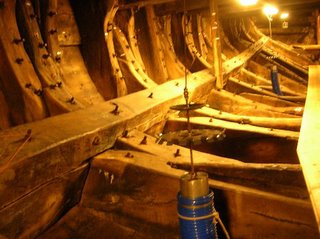 Another unusual feature of the hold is this fore and aft stringer seen only in a few ships from the 1600s. It is positively enormous yet mathematical analyses of Vasa's hull show that it offers little to the structural integrity of the ship.
Another unusual feature of the hold is this fore and aft stringer seen only in a few ships from the 1600s. It is positively enormous yet mathematical analyses of Vasa's hull show that it offers little to the structural integrity of the ship.
The blue hoses pump climate controlled air into the ship to prevent mold growth and decay.
 Moving forward through the hold, the deck overhead drops lower and lower and we finally reach the mainmast, stepped neatly into the keel. Silver coins were found beneath it in accordance with classic seafaring tradition and susperstition.
Moving forward through the hold, the deck overhead drops lower and lower and we finally reach the mainmast, stepped neatly into the keel. Silver coins were found beneath it in accordance with classic seafaring tradition and susperstition. Just forward of the mast we come to a temporary bulkhead made of light planks. It is now too low to stand but turning back is out of the question--we're almost to the galley!
Just forward of the mast we come to a temporary bulkhead made of light planks. It is now too low to stand but turning back is out of the question--we're almost to the galley!The Galley is through this opening to the left. You can see the low wall of the firepit already.
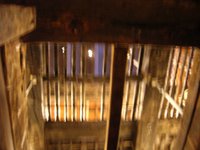 The galley was simply a brick-lined box in the hold where the cooks could safely build a fire. The smoke wafted upward through the hatches, climbing slowly toward the sky and blowing freely through the gundecks, letting all hands know exactly what was cooking.
The galley was simply a brick-lined box in the hold where the cooks could safely build a fire. The smoke wafted upward through the hatches, climbing slowly toward the sky and blowing freely through the gundecks, letting all hands know exactly what was cooking. This part of the cut-away model shows the cooking area, three decks below the weatherdeck. We are the two crouching fellows passig by in the foreground.
This part of the cut-away model shows the cooking area, three decks below the weatherdeck. We are the two crouching fellows passig by in the foreground.
Passing through another bulkhead we finally reach the forward part of the hold. Here, in this last cargo space more brilliantly lit than it ever would have been by the lanterns of the 1620s, we can see the broad, spoon-shape of Vasa's bow.
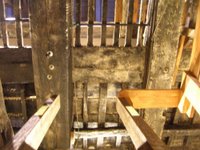
Well, we've spent quite a bit of time touring Vasa. I suppose it is time to head topside again...up, up, up, and up a little more. Four decks from the bottom of the hold until we stand in the sharp shadows of the rigging again.

Stepping 'ashore' again, I hope you will gaze back at the Royal Ship Vasa and remember that you've now had an experience which nearly a million people who come here every year will never get to see. Thanks for coming along, and as always, I wish you fair winds.

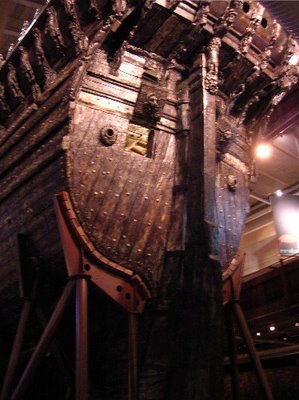

4 Comments:
So when do you get to fire a cannon? What are you going to shoot at? You must take video and try posting it!
qzz0612
canada goose outlet
ferragamo outlet
fitflops sale
merrell shoes
canada goose jackets
michael kors outlet
futbol baratas
salomon shoes
fitflops sale clearance
jordan shoes
Maintenant, cela en dit long sur un produit spécifique, pantalon asics femme noir et rose au cas où vous me le demanderiez. Nike Shox R3-R4 venir pour la planète virtuelle et acheter en toute confiance. La semelle intercalaire en PU anatomiquement conçue dissipe l'entraînement à l'impact. Les ingénieurs de Micron fabriquent non seulement la marchandise de la plus haute qualité disponible dans le monde des gaz d'échappement, nike air max thea jacquard w chaussures mais aussi certains des produits les plus uniques et les plus beaux disponibles partout. D'autres noms de marque, styles et accessoires pour enfants comprennent les sacs à dos Nike Shox R3 Air Max, Jordan Select, les lunettes de soleil Under Armour Core et bien basket new balance femme avis plus encore. De telles situations et critiques ne sont pas inhabituelles ces jours-ci.Avec les rapports sur les licenciements massifs qui ont précédé sa mise en œuvre, et les fermetures d'usines ou les délocalisations vers des juridictions moins chères par la suite, la nouvelle loi sur les contrats de travail a nike air max bw pas cher homme suscité des critiques.
christian louboutin
adidas tubular shadow
jordan shoes
curry shoes
mbt
jordans
kyrie 6
supreme new york
yeezy boost 350 v2
yeezy 700
Post a Comment
<< Home